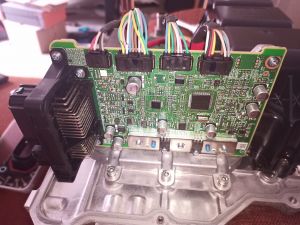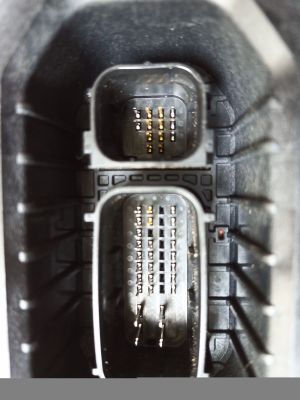Nissan Leaf Gen2 Board: Difference between revisions
Doobedoobedo (talk | contribs) (description of the kit.) |
Doobedoobedo (talk | contribs) (Added board removal a stub for the kit build and basic info on what's available on the connector) |
||
| Line 5: | Line 5: | ||
== The Kit == | == The Kit == | ||
The kit comprises a Brain board R3, a wifi board, connectors, and a bare replacement board which replaces the stock Nissan board. This board needs the supplied components and connectors to be soldered in place along with the large proprietary connector which must be salvaged from the Nissan board. | The kit comprises a Brain board R3, a wifi board, connectors, and a bare replacement board which replaces the stock Nissan board. This board needs the supplied components and connectors to be soldered in place along with the large proprietary connector which must be salvaged from the Nissan board. | ||
[[File:Nissan inverter board.jpg|alt=Nissan board, yet to be removed. The large connector on the left must be salvaged and re-used.|thumb|Nissan board, yet to be removed. The large connector on the left must be salvaged and re-used.]] | |||
== Nissan Board Removal == | |||
[[File:Nissan inverter board.jpg|alt=Nissan board, yet to be removed. The large connector on the left must be salvaged and re-used.|thumb|Nissan board, yet to be removed. The large connector on the left must be salvaged and re-used.]]The inverter casing attaches directly to the motor and may be opened by removing the 10mm hex head bolts underneath the top lip along with the waterproof guard for the large connector. | |||
Once opened the board with the controller is easily distinguished as it has the large connector attached. It is on it's own carrier attached to the lid by 3 allen head bolts. Start by disconnecting the plugs from the four connectors at the top of the board, then remove the allen bolts to free the carrier. | |||
Next remove the screws holding the board to the carrier. Nissan use some very strong thread lock so be prepared for some of the screw heads to shear, the sheared stubs can be removed afterwards using heat to burn off the thread lock. | |||
[[File:Nissan Proprietary connector.jpg|alt=Nissan Proprietary connector as seen from outside the housing.|thumb|Nissan Proprietary connector as seen from outside the housing.]] | |||
[[File:Leaf adapter pin map.png|alt=Pin function descriptions, pins as seen from outside the housing|thumb|Proprietary connector pin function descriptions, pins as seen from outside the housing.]] | |||
Once the board has been removed from the carrier the large connector must be salvaged from it. One method is shown in the swap video, a vacuum soldering iron is also known to work. | |||
== Kit Build == | |||
Solder the components to the board as per the instructions. Use fresh screws to attach the board to the carrier and bolt it back in place using the allen head screws. Next plug in the brain board and wifi adapter. | |||
== Proprietary Connector == | |||
Not all pins of the connector are available. The top group are blanked off, so the brake and BMS signals are not available. | |||
The resolver and CAN bus signals remain on the same pins as used by Nissan. If other signals are required then they must be added to the female connector. | |||
Revision as of 23:09, 26 February 2020
Shop link: https://openinverter.org/shop/index.php?route=product/product&product_id=57
Swap video: https://www.youtube.com/watch?v=T_6hw6vGzfM
The Kit
The kit comprises a Brain board R3, a wifi board, connectors, and a bare replacement board which replaces the stock Nissan board. This board needs the supplied components and connectors to be soldered in place along with the large proprietary connector which must be salvaged from the Nissan board.
Nissan Board Removal
The inverter casing attaches directly to the motor and may be opened by removing the 10mm hex head bolts underneath the top lip along with the waterproof guard for the large connector.
Once opened the board with the controller is easily distinguished as it has the large connector attached. It is on it's own carrier attached to the lid by 3 allen head bolts. Start by disconnecting the plugs from the four connectors at the top of the board, then remove the allen bolts to free the carrier.
Next remove the screws holding the board to the carrier. Nissan use some very strong thread lock so be prepared for some of the screw heads to shear, the sheared stubs can be removed afterwards using heat to burn off the thread lock.
Once the board has been removed from the carrier the large connector must be salvaged from it. One method is shown in the swap video, a vacuum soldering iron is also known to work.
Kit Build
Solder the components to the board as per the instructions. Use fresh screws to attach the board to the carrier and bolt it back in place using the allen head screws. Next plug in the brain board and wifi adapter.
Proprietary Connector
Not all pins of the connector are available. The top group are blanked off, so the brake and BMS signals are not available.
The resolver and CAN bus signals remain on the same pins as used by Nissan. If other signals are required then they must be added to the female connector.


